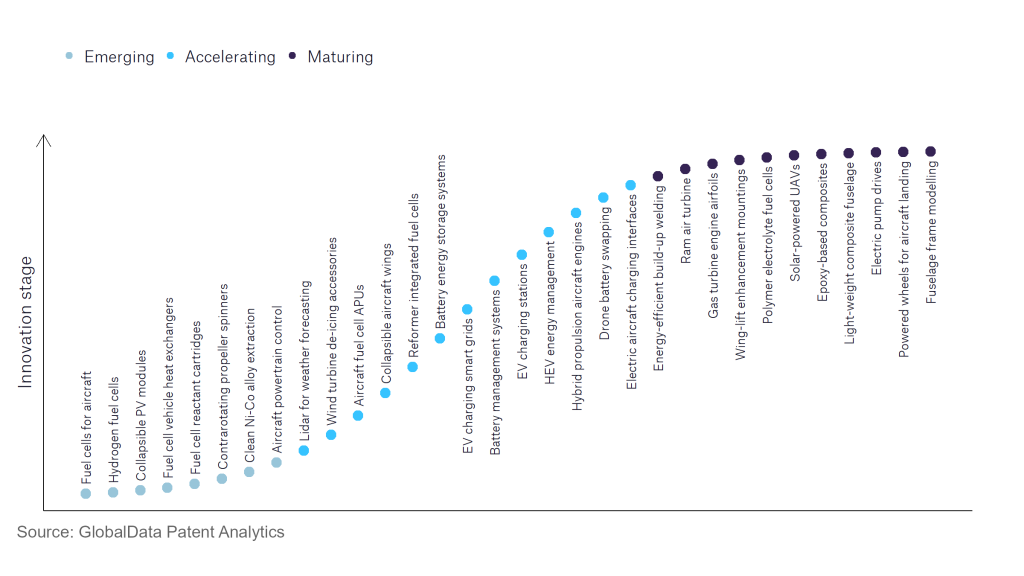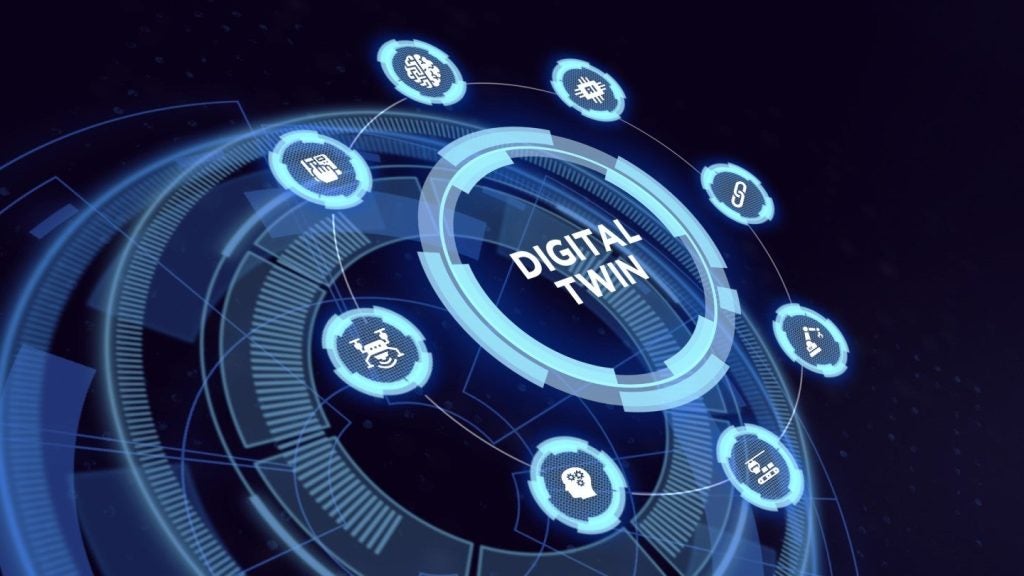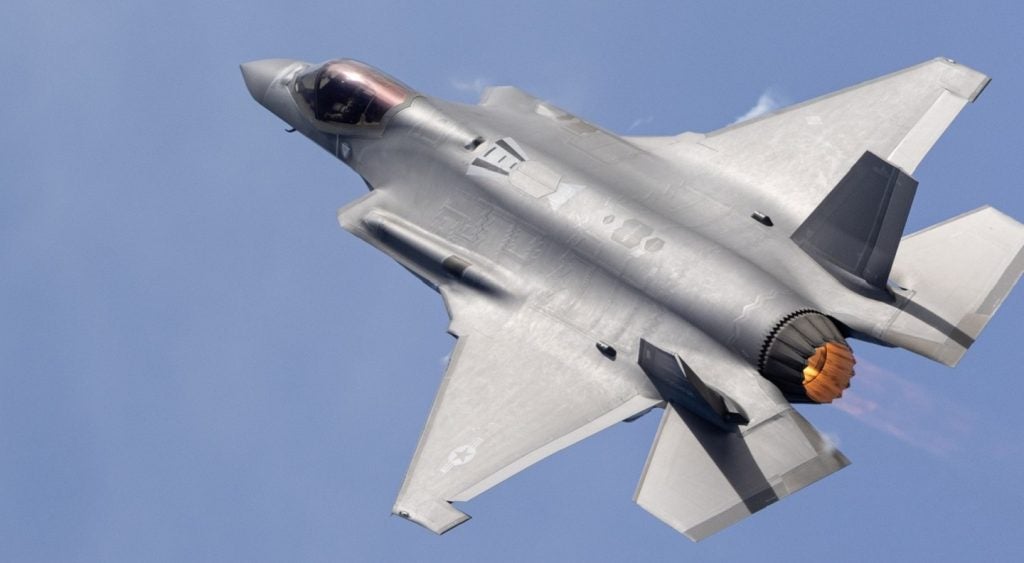The aerospace and defence industry continues to be a hotbed of innovation, with activity driven by the need to lower operational costs, larger consumer trends, and electrification, and growing importance of technologies such as hydrogen and electric aircraft and advanced materials. In the last three years alone, there have been over 174,000 patents filed and granted in the aerospace and defence industry, according to GlobalData’s report on Environment Sustainability in Aerospace, Defence & Security: Hydrogen fuel cells. Buy the report here.
However, not all innovations are equal and nor do they follow a constant upward trend. Instead, their evolution takes the form of an S-shaped curve that reflects their typical lifecycle from early emergence to accelerating adoption, before finally stabilising and reaching maturity.
Identifying where a particular innovation is on this journey, especially those that are in the emerging and accelerating stages, is essential for understanding their current level of adoption and the likely future trajectory and impact they will have.
See Also:
180+ innovations will shape the aerospace and defence industry
According to GlobalData’s Technology Foresights, which plots the S-curve for the aerospace and defence industry using innovation intensity models built on over 262,000 patents, there are 180+ innovation areas that will shape the future of the industry.
Within the emerging innovation stage, hydrogen fuel cells, and fuel cells for aircraft are disruptive technologies that are in the early stages of application and should be tracked closely. Hybrid propulsion aircraft engines, Drone battery swapping, and HEV energy management are some of the accelerating innovation areas, where adoption has been steadily increasing. Among maturing innovation areas are fuselage frame modelling and Light-weight composite fuselage, which are now well established in the industry.
Innovation S-curve for environmental sustainability in the aerospace and defence industry

Hydrogen fuel cells is a key innovation area in environmental sustainability
By combining hydrogen and air in the presence of a catalyst, fuel cells produce electricity to drive electric motors, the only by-product being water vapour. Compared to batteries, fuel cells are more energy converters than storage devices.
GlobalData’s analysis also uncovers the companies at the forefront of each innovation area and assesses the potential reach and impact of their patenting activity across different applications and geographies. According to GlobalData, there are 30+ companies, spanning technology vendors, established aerospace and defence companies, and up-and-coming start-ups engaged in the development and application of hydrogen fuel cells.
Key players in hydrogen fuel cells – a disruptive innovation in the aerospace and defence industry
‘Application diversity’ measures the number of different applications identified for each relevant patent and broadly splits companies into either ‘niche’ or ‘diversified’ innovators.
‘Geographic reach’ refers to the number of different countries each relevant patent is registered in and reflects the breadth of geographic application intended, ranging from ‘global’ to ‘local’.
Patent volumes related to hydrogen fuel cells
| Company | Total patents (2010 - 2022) | Premium intelligence on the world's largest companies |
| CEA | 473 | Unlock Company Profile |
| Airbus | 287 | Unlock Company Profile |
| Safran | 113 | Unlock Company Profile |
| Raytheon Technologies | 72 | Unlock Company Profile |
| ThyssenKrupp | 40 | Unlock Company Profile |
| Boeing | 36 | Unlock Company Profile |
| Siemens | 34 | Unlock Company Profile |
| Doosan | 27 | Unlock Company Profile |
| General Electric | 27 | Unlock Company Profile |
| Diehl Stiftung | 24 | Unlock Company Profile |
| Honeywell International | 23 | Unlock Company Profile |
| Meditor European Master Fund | 22 | Unlock Company Profile |
| Hyundai Motor Group | 22 | Unlock Company Profile |
| Toyota Motor | 21 | Unlock Company Profile |
| Naval Group | 17 | Unlock Company Profile |
| Korea Development Bank | 16 | Unlock Company Profile |
| Textron | 15 | Unlock Company Profile |
| Solar Ship | 15 | Unlock Company Profile |
| Liebherr-International | 13 | Unlock Company Profile |
| BAE Systems | 11 | Unlock Company Profile |
| ArianeGroup | 11 | Unlock Company Profile |
| EADS Deutschland | 11 | Unlock Company Profile |
| SZ DJI Technology | 9 | Unlock Company Profile |
| Zodiac Seats France | 9 | Unlock Company Profile |
| Linde | 8 | Unlock Company Profile |
| Rolls-Royce Holdings | 8 | Unlock Company Profile |
| NACCO Materials Handling Group | 8 | Unlock Company Profile |
| X Development | 7 | Unlock Company Profile |
| Deutsches Zentrum fur Luft- und Raumfahrt | 6 | Unlock Company Profile |
| Lynntech | 6 | Unlock Company Profile |
| Kia | 6 | Unlock Company Profile |
| Spawnt Private | 6 | Unlock Company Profile |
| Alakai Technologies | 5 | Unlock Company Profile |
| Howaldtswerke-Deutsche Werft | 5 | Unlock Company Profile |
| Porsche Automobil Holding | 5 | Unlock Company Profile |
| General Motors | 5 | Unlock Company Profile |
| UAV Factory | 5 | Unlock Company Profile |
Source: GlobalData Patent Analytics
Airbus is the leading patent filer for Hydrogen Fuel cells and believes that it forms an important part for them to achieve a zero-emission aircraft by 2035. Other players in the space are Safran, Raytheon Technologies, Boeing and GE. CFM International, a 50/50 partnership between GE and Safran Aircraft Engines, recently entered into an agreement to collaborate on the development of Hydrogen Combustion Engine.
In terms of application diversity, Rolls-Royce leads the pack, followed by Hyundai, Boeing and GE. Geographic reach though was headed by Naval Group, with ThyssenKrupp, Solar Ship and Doosan following.
Hydrogen fuel cells and hydrogen powered flight looks to have a bright future with the largest benefit of the technology being that it is emission free, and the only by-product is water.
To further understand the key themes and technologies disrupting the aerospace and defence industry, access GlobalData’s latest thematic research report on Defence.
Premium Insights
From

The gold standard of business intelligence.
Blending expert knowledge with cutting-edge technology, GlobalData’s unrivalled proprietary data will enable you to decode what’s happening in your market. You can make better informed decisions and gain a future-proof advantage over your competitors.






